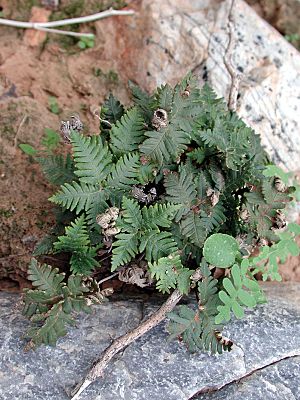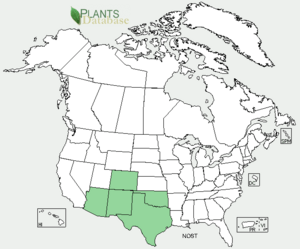Star cloak fern facts for kids
Quick facts for kids Star cloak fern |
|
|---|---|
 |
|
| Notholaena standleyi. Standley's cloak fern from Phoenix Mountains Preserve, Maricopa County, Arizona, USA. | |
| Scientific classification | |
| Genus: |
Notholaena
|
| Species: |
standleyi
|
Notholaena standleyi, also called the star cloak fern or Standley's cloak fern, is a type of fern. It grows naturally in the United States and Mexico. This fern belongs to a group of plants called Notholaena.
What makes this fern special is the unique shape of its leaves. They form a five-sided, or pentagonal, shape. Other ferns in the Notholaena group do not have this distinct shape.
Contents
About the Standley's Cloak Fern
How the Fern Got Its Name
The Notholaena standleyi fern was named after Paul C. Standley. He was a scientist who studied plants in the southwestern United States.
In 1864, this fern was first described with a different name. Later, in 1879, it was given a new name, Notholaena hookeri. However, that name was already used for another fern. So, in 1915, William R. Maxon renamed it. He chose to name it after Standley because of all his important work. Standley spent a lot of time studying plants in the field.
Where This Fern Lives
The Standley's cloak fern is found in the southwestern United States and parts of Mexico. In the USA, you can find it in Arizona, Colorado, New Mexico, Oklahoma, and Texas.
Habitat and Life Cycle
The Standley's cloak fern is a perennial plant. This means it lives for more than two years. It usually grows in desert areas. You can find it at elevations from about 300 to 2100 meters (about 980 to 6,900 feet).
It often grows on rocky hillsides. It likes to hide in cracks in limestone and granite rocks. These spots give the fern some shade, which it prefers. When there is not much rain, the fern's leaves might curl up and turn brown. This helps it survive dry periods. When water returns, the leaves can uncurl and turn green again.
The fern's spores take about 13 days to sprout. It produces new spores from late spring to fall. Like all ferns, it has a special life cycle. The main fern plant, called the sporophyte, makes tiny spores. These spores are like seeds. They grow into a small plant called a gametophyte. The gametophyte then makes reproductive cells. When these cells join, they form a new sporophyte. Spores are carried by wind and water to new places.
What the Fern Looks Like
This fern has brown stems, called petioles, and green leaves, called fronds. The fern stands upright and can grow up to 25 centimeters (about 10 inches) tall. Its petioles can be 5 to 13 centimeters (2 to 5 inches) long.
The fronds are usually 3 to 7 centimeters (1 to 3 inches) wide and long. When they are young, the fronds are light green. As they get older, they turn a darker green. Each frond usually has five parts, arranged in a pentagonal shape. These parts are divided into smaller, triangular sections.
The underside of the frond is covered with a powdery substance called farina. Scientists are still studying what this powder does. The color of the farina can be different depending on where the fern grows. These different types are called chemotypes. Some have gold or yellow farina, while others have pale or yellow-green farina. These types also have different numbers of chromosomes, which are like the instruction manuals inside cells.
The fern's early growth stage, called the prothallus, has tiny hairs called trichomes. The fern usually produces 32 spores in each spore case (sporangium). However, some have been seen with only 16 spores. This fern has 60 chromosomes in its root cells.
How People Used This Fern
The Seri Indians, a native group, used the fronds of this fern. They made a tea from them. This tea was believed to help women have babies. The Seri people also thought the fern had special powers. They would carry a small bag with the fern in it for good luck.
Scientists have also studied this fern for its possible use in medicine. It has shown some activity against viruses, like the one that causes cold sores. A substance found in the fern, called Notholaenic acid, has been shown to fight this virus in lab tests.


